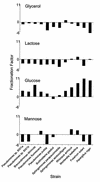Ratios of carbon isotopes in microbial lipids as an indicator of substrate usage
- PMID: 9797266
- PMCID: PMC106628
- DOI: 10.1128/AEM.64.11.4202-4209.1998
Ratios of carbon isotopes in microbial lipids as an indicator of substrate usage
Abstract
The occurrence and abundance of microbial fatty acids have been used for the identification of microorganisms in microbial communities. However, these fatty acids can also be used as indicators of substrate usage. For this, a systematic investigation of the discrimination of the stable carbon isotopes by different microorganisms is necessary. We grew 11 strains representing major bacterial and fungal species with four different isotopically defined carbon sources and determined the isotope ratios of fatty acids of different lipid fractions. A comparison of the differences of delta13C values of palmitic acid (C16:0) with the delta13C values of the substrates revealed that the isotope ratio is independent of the growth stage and that most microorganisms showed enrichment of C16:0 with 13C when growing on glycerol. With the exception of Burkholderia gladioli, all microorganism showed depletion of 13C in C16:0 while incorporating the carbons of glucose, and most of them were enriched with 13C from mannose, with the exception of Pseudomonas fluorescens and the Zygomycotina. Usually, the glycolipid fractions are depleted in 13C compared to the phospholipid fractions. The delta13C pattern was not uniform within the different fatty acids of a given microbial species. Generally, tetradecanoic acid (C14:0) was depleted of 13C compared to palmitic acid (C16:0) while octadecanoic acid (C18:0) was enriched. These results are important for the calibration of a new method in which delta13C values of fatty acids from the environment delineate the use of bacterial substrates in an ecosystem.
Figures




References
-
- Abraham W-R, Meyer H, Lindholst S, Vancanneyt M, Smit J. Phospho- and sulfolipids as biomarkers of Caulobacter, Brevundimonas and Hyphomonas. Syst Appl Microbiol. 1997;20:522–539.
-
- Abrajano T A, Jr, Murphy D E, Fang J, Comet P, Brooks J M. 13C/12C ratios in individual fatty acids of marine mytilids with and without bacterial symbionts. Org Geochem. 1994;12:611–617.
Publication types
MeSH terms
Substances
LinkOut - more resources
Full Text Sources
Other Literature Sources
Medical
Molecular Biology Databases

